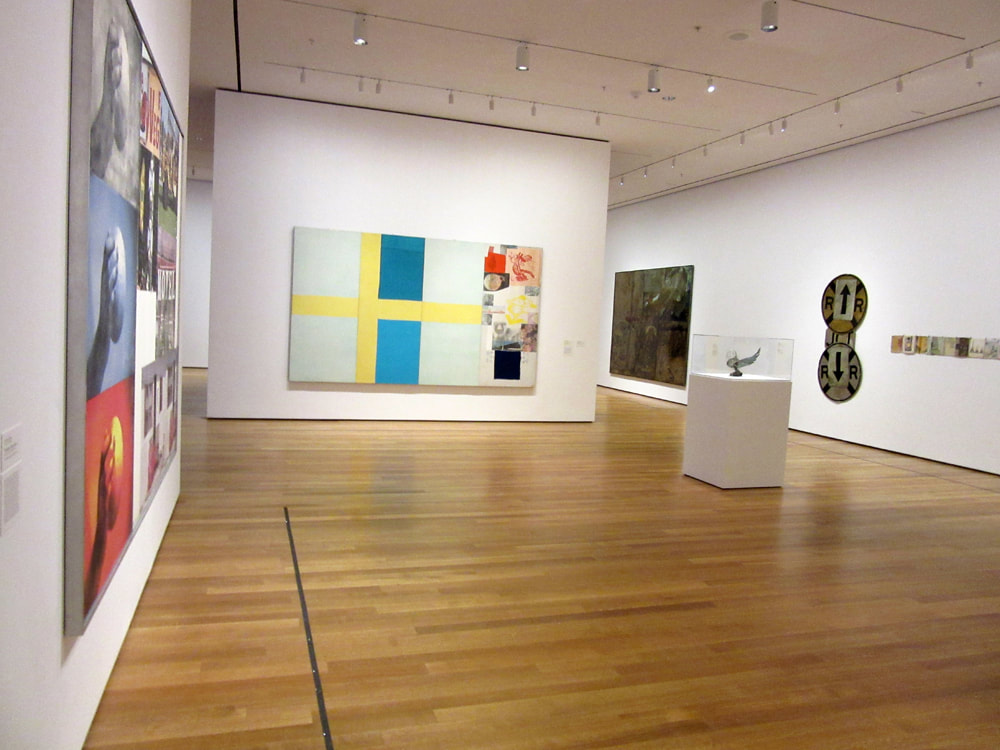|
“Robert Rauschenberg: Among Friends” at the Museum of Modern Art in New York is the first 21st century retrospective of Robert Rauschenberg's work. Extending over several rooms, it is a well-organized survey of the artist's career.
Rauschenberg was born in Port Arthur, Texas and was initially going to be a pharmacist. However, World War II intervened and he was drafted into the United States Navy where he worked as a technician in a mental hospital. Following the war, he shifted his focus to art and studied at the Kansas City Art Institute, the Academie Julian in Paris and at Black Mountain College in North Carolina. He also studied at the Art Students League in New York City. The League was a center of creativity in the late 1940s with a good camaraderie among the students. To illustrate, my mother (see Art by Valda) also studied there at that time. Some 20 odd years later, I recall her mentioning that she had just spoken to Rauschenberg on the telephone about some artistic problem that she was trying to solve. This took place even though they now inhabited different worlds and their approaches to art were quite different. In the 1950s, Rauschenberg established himself as a successful artist and by the 1960s, he was already having one-man retrospective shows. His influential work was described as Neo-dada and he is credited with being a forerunner of the Pop Art movement. The exhibit at MOMA contains some 250 works including some of his best known works such as “Bed”, “Canyon” and “Monogram.” As can be expected from MOMA, the works are displayed to advantage with a substantial amount of supporting information both posted near the works and on MOMA's free app. The challenge in presenting a retrospective of an artists of the stature of Rauschenburg is to do so in a way that enables the viewer to draw conclusions about the artist and his works. The first lesson I learned from this exhibition was that Rauschenberg's work was evolutionary. In general, the exhibit presents Rauschenburg's work chronologically. The works that one encounters at the beginning of the exhibit are much different than the works at the other end. Rauschenberg continued to grow throughout his career. I was also impressed by his innovation. Rauschenberg sought to erase the boundaries between art and everyday life. Indeed, he is well-known for employing non-traditional materials and found objects in his works. This broadened the avenues for artistic expression. It also provoked viewers to think in new ways about the world around them. Rauschenberg sought to provoke thought. Critics and academics attribute various meanings to his works. However, Rauschenberg declined to reveal their “true meaning.” His belief was that the meaning was in the control of the viewer. The work only created paths for dialogue. The viewer's thought process could change depending upon when he or she was viewing the work and what was happening in his or her life. Consequently, a work can have many meanings, all of which are valid. We also see that creating art does not have to be a solitary pursuit. From his early work with his wife, the painter Susan Well, Rauschenberg collaborated with other artists. This includes people from the world of music and dance such as John Cage and Merce Cunningham as well as scientists who brought knowledge of technology to the effort. For the most part, Rauschenberg's works are not aesthetically pleasing. You do not come away from one of his works thinking that it would look great in your living room. Like many intellectuals of his time, Rauschenberg resisted the idea that art should be pretty. As a result, he was uncomfortable with some of the pieces he created in the 1970s employing hand-spun silk fabrics that he found on a trip to India. They are by far the most eye pleasing works in the exhibit. Comments are closed.
|
AuthorRich Wagner is a writer, photographer and artist. Archives
November 2018
Categories
All
|

 RSS Feed
RSS Feed